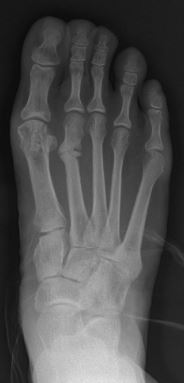
Photo from wikipedia
BACKGROUND The purpose of this study was to determine the frequency of concurrent ipsilateral distal tibial fractures with tibial shaft fractures in the pediatric population; to identify patient and fracture… Click to show full abstract
BACKGROUND The purpose of this study was to determine the frequency of concurrent ipsilateral distal tibial fractures with tibial shaft fractures in the pediatric population; to identify patient and fracture characteristics that increase the likelihood of a concurrent fracture; and determine if any of these concurrent distal tibial fractures were missed on initial radiographic examination. METHODS Retrospective chart review was done to identify patients 5 to 17 years old who were treated for a tibial shaft fracture at a large, Level 1 free-standing children's hospital and an outpatient orthopaedic practice between 2008 and 2016. Patient and fracture characteristics were recorded. RESULTS Of 517 fractures (515 patients), 22 (4.3%) had concurrent ipsilateral distal tibial fractures: 11 triplane, 5 medial malleolar, 3 bimalleolar, and 2 Tillaux (Salter-Harris III) ankle fractures, and 1 Salter-Harris II distal tibial fracture. Age was the only patient characteristic significantly associated with a second, more distal fracture: patients with both fractures were older (12.7 y) than those with an isolated tibial shaft fracture (11 y). There was no difference in the rate of distal tibial fractures between high-energy and low-energy mechanisms of injury and no differences in the rate of open injuries or the presence of a fibular fracture. Patients with a tibial shaft fracture at the junction of the middle and distal thirds were significantly more likely to have a concurrent distal tibial fracture; oblique and spiral fracture patterns were more frequent in the group with concurrent distal tibial fractures than in the isolated tibial shaft fracture group. CONCLUSIONS In our series, 36% of the concurrent distal tibial fractures were not diagnosed until chart review for this study, which suggests the need for ankle-specific imaging in certain patients. We recommend ankle-specific imaging when an oblique or spiral tibial shaft fracture is located at the junction of the middle and distal thirds of the tibia or in patients in whom a distal tibial fracture is suspected because of pain, swelling, or bruising. LEVEL OF EVIDENCE Level III-retrospective comparative study.
Journal Title: Journal of Pediatric Orthopaedics
Year Published: 2019
Link to full text (if available)
Share on Social Media: Sign Up to like & get
recommendations!